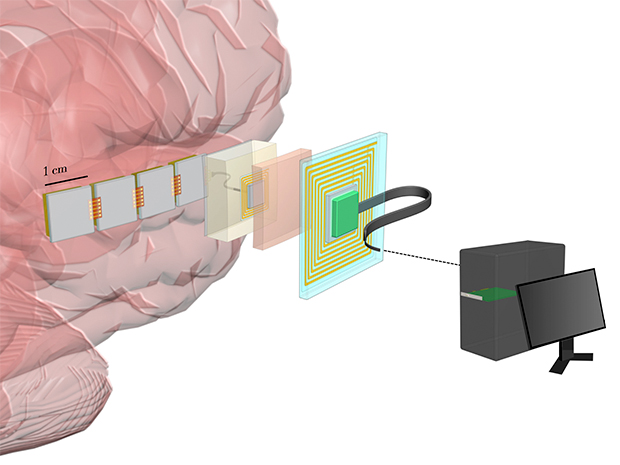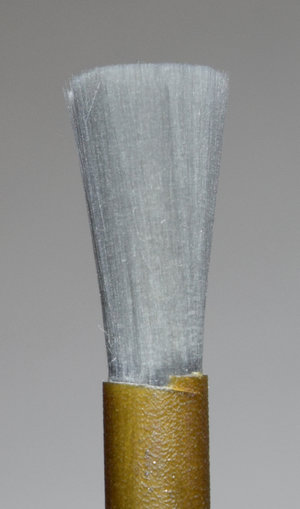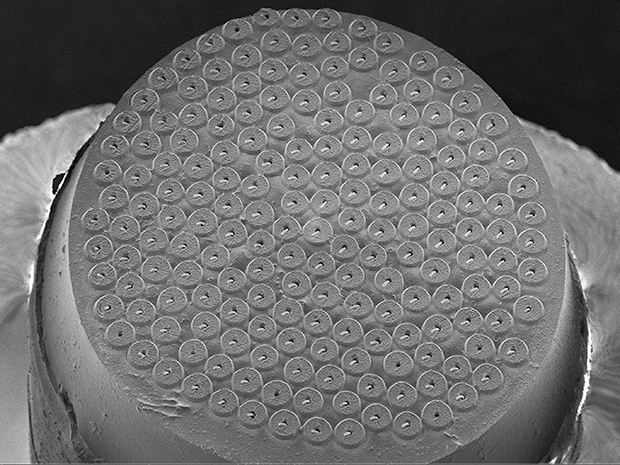DARPA has ordered the development of high-resolution brain implants for a brain-computer interface

Illustration: Paradromics
The Department of Advanced Research Projects of the United States Department of Defense (DARPA) has entered into six contracts for the development of neural interfaces under the Neural Engineering System Design (NESD) program . This program aims to "significantly improve the possibilities for neurotechnology research and provide a basis for new therapies."
In practice, DARPA aims to develop an implantable neural interface that will provide "unprecedented signal resolution and data transfer speeds between the human brain and the digital world." In the technical project it is indicated that the interface should work as a converter-translator, converting the electrochemical signals of the brain into a digital code (zeros and ones), which is used in computer science. And perform the inverse transform to write data to the brain. The goal is a communication device for a brain-computer interface of no more than 1 cm 3 .
Contracts are concluded with five research organizations and one commercial company:
- Brown University . Decoding neural processing of speech with an emphasis on tone and vocalization. The interface consists of 100 00 sensors (neurograin), implanted on the surface or inside the cerebral cortex. A separate radio module provides power to the implant and serves as a hub for transmitting data to and from the control center. There, in turn, transcoding and processing of neural and digital signals is performed.
- Columbia University . Bioelectric interface in the visual cortex using a CMOS flexible chip with an integrated array of electrodes. On the head of a person, a rental station is mounted for signal transmission and wireless energy transfer to the implant.
- Fondation Voir et Entendre (Foundation for Sight and Hearing). The interface of optogenetic communication between the neurons of the visual cortex and the high-resolution artificial retina with a video camera, which is installed in place of the eye.
- John B. Pierce Laboratory . The study of vision. Interface for communication with modified neurons capable of bioluminescence and reacting to optogenetic stimulation.
- University of California, Berkeley . Holographic microscope "light field", which is able to record and modulate the activity of up to 1 million neurons of the cerebral cortex . Attempt to create coding models to predict the response of neurons to external visual and tactile stimulation, and then apply these patterns to restore vision in blind patients or control artificial prostheses using mental commands.
- Paradromics, Inc. High-speed interface to the cerebral cortex through the grid of penetrating microwires to stimulate individual neurons and remove information from them in high resolution. It is assumed that the implant will help restore speech functions.


The diameter of each microwire Paradromics less than 20 microns
“Today, the best systems with a brain-computer interface are like two supercomputers trying to communicate at 300 baud,” says Phillip Alvelda, NESD program manager. “Imagine what prospects will open up if we update our tools and really open the channel between the human brain and modern electronics.”
Among the most obvious applications of the new interface is information compensation for people with hearing and vision impairments. They will be able to receive the necessary picture and sound directly to the brain, and its resolution can theoretically exceed the capabilities of natural human vision and hearing (for example, data for transmission can be taken from directional microphones, infrared cameras and thermal imagers). Probably, such interfaces will be used in military affairs.
To date, the best neural interfaces collect information on only 100 channels, each of which combines information from tens of thousands of neurons at the same time. The result is a blurry and noisy low-resolution picture that does not allow for the accurate restoration of individual thoughts and images from the brain. In contrast, the NESD program aims to create high-resolution neural interfaces that will read and write data clearly and accurately from each of 1 million individual neurons.
Although the task of reading data from 1 million neurons individually looks fantastic, but this number represents only a tiny fraction of the 86 billion neurons that make up the human brain. So this is only the first step to unraveling the mysteries of human thinking.
DARPA plans to allocate $ 65 million over four years for research. In the first year, developers will focus on conceptual innovations in the field of hardware and software, and will also conduct experiments on animals and cultured cages. At the second stage, basic research, work on component miniaturization and integration will begin, as well as cooperation with the FDA on the regulation of new technologies.
Developers have to overcome a number of technical obstacles, but these six groups have managed to formulate their plans and convince DARPA that they can be implemented.
All Articles